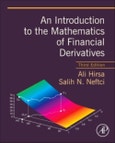An Introduction to the Mathematics of Financial Derivatives is a popular, intuitive text that eases the transition between basic summaries of financial engineering to more advanced treatments using stochastic calculus. Requiring only a basic knowledge of calculus and probability, it takes readers on a tour of advanced financial engineering. This classic title has been revised by Ali Hirsa, who accentuates its well-known strengths while introducing new subjects, updating others, and bringing new continuity to the whole. Popular with readers because it emphasizes intuition and common sense, An Introduction to the Mathematics of Financial Derivatives remains the only "introductory" text that can appeal to people outside the mathematics and physics communities as it explains the hows and whys of practical finance problems.
Please Note: This is an On Demand product, delivery may take up to 11 working days after payment has been received.
Table of Contents
1: Financial Derivatives: A Brief Introduction
2: A Primer on Arbitrage Theorem
3: Review of Deterministic Calculus
4: Pricing Derivatives: Models and Notations
5: Tools in Probability Theory
6: Martingales and Martingale Representations
7: Wiener Process, Levy Processes, and Rare Events
8: Differentiation in Stochastic Environments
9: Integration in Stochastic Environments
10: Ito's Lemma
11: The dynamics of Derivatives Prices: Stochastic Differential
12: Pricing Derivatives Products via Partial Differential Equations
13: Equivalent Martingale Measures
14: Equivalent Martingale Measures: Applications
15: Arbitrage Theorem in a New Setting
16: Term Structure Modeling and Related Concepts
17: Approaches to Modeling Term Structure
18: Conditional Expectations and PDEs
19: Derivative Pricing via Transform Techniques
20: Credit Spread and Credit Derivatives
21: Stopping Times and American-Style Derivatives
22: A Primer on Calibration and Estimation Techniques
Authors
Ali Hirsa Columbia University, New York; and New York University, New York, USA. Ali Hirsa is a professor and co-director of financial engineering at the Industrial Engineering & Operations Research at Columbia University. He is also Managing Partner at Sauma Capital, LLC and Senior Advisor at DV Trading, LLC where he was Managing Director and Global Head of Quantitative Strategy from June 2016 to August 2017. Ali was a Fellow at Courant Institute of New York University in the Mathematics of Finance Program from 2004 to 2014. He is co-inventor of "Methods for Post Trade Allocation� (US Patent 8,799,146). The method focuses on allocation of filled orders (post-trade) on any security to multiple managed accounts which has to be fair and unbiased. Current existing methods lead to biases and the invention provides a solution to this problem. Salih N. Neftci Late of the Global Finance Master's Program, New School for Social Research, New York, NY, USA. Professor Neftci completed his Ph.D. at the University of Minnesota and was head of the FAME Certificate program in Switzerland. He taught at the Graduate School, City University of New York; ICMA Centre, University of Reading; and at the University of Lausanne. He was also a Visiting Professor in the Finance Department at Hong Kong University of Science and Technology. Known his books and articles, he was a regular columnist for CBN daily, the most influential financial newspaper in China.Salih Neftci was already suffering from gliosarcoma, a malignant brain cancer, while writing the second edition. It published just 5 months before his death on April 15, 2009.








